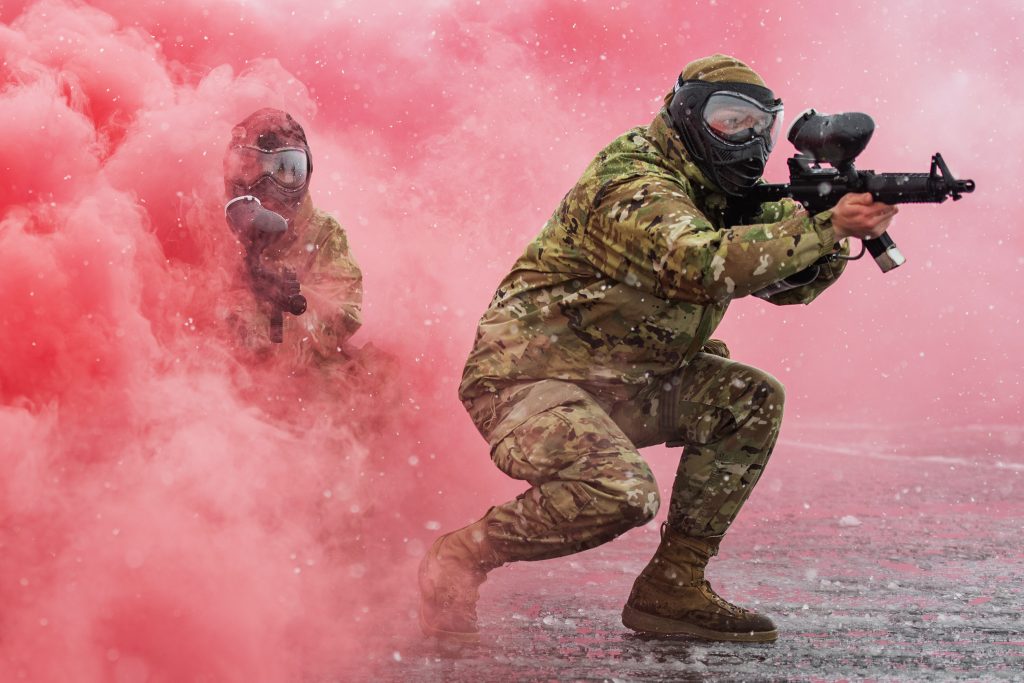Total Force: Army, Air, Navy train together in mass casualty combat exercise

Master Sgt. Becky Vanshur/Idaho Military Division Public Affairs
BOISE, Idaho – A deep breath in, deep breath out. An Airman from the Idaho Air National Guard holds his weapon steady in front of him, pressing it against his shoulder, finger on the trigger, his body low to the ground. He takes a small, strategic step into the plume of smoke swirling around him. Surrounded by a blanket of red smoke makes it hard to see his battle buddy but he knows his counterpart, a Soldier from the Idaho Army National Guard’s Medical Detachment, is close behind him.
The red smoke is used to conceal the medical team’s movements as they defend their medical structures and personnel who are being ambushed while conducting Tactical Combat Casualty Care on the battlefield. The two Guardsmen were among approximately 200 Idaho National Guard Soldiers, Airmen and their active duty and Navy Reserve counterparts who joined forces for a mass casualty combat exercise, Feb. 1-4, near Gowen Field.
“The main focus of this joint services training was to all come together, learn each other’s jobs and create multi-capable Soldiers, Airmen and Sailors on top of learning how to respond in mass casualty scenarios,” said Senior Master Sgt. Davis Nguyen, the 124th Medical Group function area manager. “Equally important, was the ability to perform medical care while under mental and physical stress.”
The Idaho Air National Guard’s Critical Care Air Transport Team, the ground surgical team and other medical personnel from the 124th Medical Group conducted the exercise with the Idaho Army National Guard’s Charlie Company, 145th Brigade Support Battalion Medical Detachment and medevac Soldiers from the 1st of the 168th Aviation Regiment; the Navy Operational Support Center; and active duty Airmen with the 366th Medical Group from Mountain Home Air Force Base.
During the exercise, Soldiers, Airmen and Sailors learned each other’s roles on the battlefield and in the sky. The Idaho Army National Guard’s State Aviation Group incorporated UH-60 Black Hawk helicopters and pilots who responded to 9-Line medevac requests, transporting critical care patients with CCATT officers and medevac Soldiers who stabilized them onboard while flying through simulated combat zones until they reached a higher echelon of care.
“All of our pilots need to practice this piece of the exercise and learn how to fly with patients in the back,” said Chief Warrant Officer 3 Theron Cameron, instructor pilot and medical evacuation officer from the 168th Aviation Regiment. “We need to learn the CCATT’s language to know if they are in the middle of performing a procedure as it cues us to fly as smoothly as possible through the combat areas, while communicating back that we may need to aggressively maneuver around danger.”
Airmen from the 124th Fighter Wing’s Security Forces provided combat lessons on defense and protection, 360-degree security, care under fire and tactical movements with red smoke concealment.
Colin Yates, an Idaho Peace Officers Standards and Training instructor specializing in wounds and trauma for tactical medicine, created realistic wounds on 124th Fighter Wing’s Student Flight role players acting as casualties for a more real-world training experience of TCCC on the battlefield.
Sailors from the NOSC provided the medical logistics support for the simulated deployment location, while learning from both Army and Air medics on tactical field care, casualty evacuation and Roles 1-4 medical care facilities.
“It’s anticipated in future conflicts, there will be a lot more integration with forces. We need to interact with each other and speak each other’s languages,” said Maj. Mark Urban, CCATT physician. “This exercise was developed with that in mind, being able to integrate is really key to that Total Force concept.”
 Official Government Website
Official Government Website